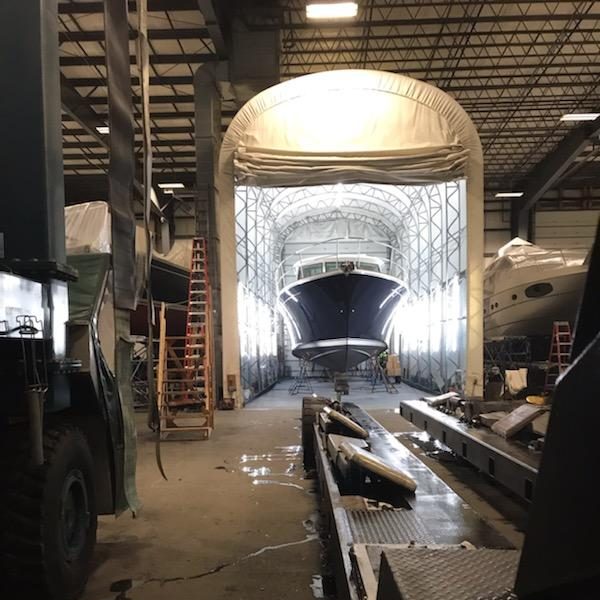The first Sabre 58 Salon Express left our Raymond facility one year ago, on December 21, 2019. Now, after a whirlwind 2020, hulls #004 and #005 are being commissioned and prepped for delivery.
Our readers who followed hull #001’s progress last year will remember that the Sabre 58 Salon Express is too large to deliver over land. In fact, our designers had to account for shipping logistics early in the concept phase of the Sabre 58’s design to ensure she could travel from our facilities to a local commissioning yard, and even accounted for the custom hydraulic trailer necessary to move her.
But the trip itself involves much more than a truck driver. Local police and numerous utility vehicles escort the Sabre 58 to clear the way, manage traffic, raise power lines, and adjust streetlights. This complicated maneuvering isn’t sustainable over long distances, so this is the only trip the Sabre 58 makes on a truck. She completes her journey over the water, a unique circumstance that allows Sabre Engineers to facilitate the commissioning process directly. There is no other model in the current Sabre lineup that is commissioned by the Sabre team, so we’re drawing back the curtain for a peek into the unique Sabre 58 commissioning process.
Today, we’re pulling back the curtain for an inside look at the commissioning process!
Once the Sabre 58 arrives at the yard, the commissioning process’s first step is to install the Volvo-Penta IPS Pods. A forklift fixture is used to carefully position the IPS drives while they are bolted and torqued into the proper position. Once the pods are in place, the exhaust systems are connected, including the Clear Wak bypass exhaust system. This involves bringing the engine temperature above 120 degrees Farenheight with the drives in neutral, then the exhaust is bypassed through the side of the hull.
At this point, the driveshafts and driveshaft scatter shields are connected, the gear oil cooling hoses are attached, and all IPS harness and electrical connections to the drive pods are secured. Finally, the initial drive alignment is performed by a Volvo-certified technician, and the ISO Class 1 & Balanced props are installed. In all, this step usually involves two or three Sabre associates, a Volvo-certified technician from New England Power Products, and a trained forklift operator from the yard.
Next, the yard will apply barrier coat, bottom paint, and exterior varnish. It is the most time-consuming step of the commissioning process, but the results are worth the wait! Meanwhile, the Sabre Engineering team uses this time to load necessary gear onto the boat, including safety equipment, lines, fenders, and the anchor and chain. Once the paint and varnish are finished, Sabre engineers install the mast and electronics hardware, including any optional SAT domes.
Before launch, her fuel tanks are filled, fuel tank senders are calibrated, engines and generators are primed, and the water tanks are filled.
Once she’s tied at the dock, our engineers must conduct thorough systems checks before conducting her first sea trial, starting with shore power and generator inputs. Then electronics are set up and tested, including the proprietary wifi, sentinel, Volvo “Easy Connect,” Dometic “Cap Touch, “and all wifi-enabled thermostats. The CZone system is calibrated to read AC & DC currents and voltages accurately, and if the vessel includes the optional entertainment package, then those systems are tested. The air conditioning split system is vacuum leak checked and charged with proper refrigerant before undergoing thorough testing. Finally, engineers check the engine isolation mount loading and test potable, grey, and black water systems.
Finally, it’s time for the sea trial and shakedown cruise! And, of course, there’s another checklist. This includes a prop check to ensure proper engine-rated rpm, percent engine loading, pressures, temperatures, and ensures there are no drivetrain vibrations. The optional Seakeeper undergoes its first spool-up and initial test run, and then it’s on to electronic calibration. Some of the final steps are autopilot calibration, tuning the optional radar overlay of the chart plotter, testing Volvo Interceptors, and the optional “Active Ride” feature.
When all systems and equipment have passed inspection, the Sabre engineering team completes an extensive orientation with a dealer representative, owner, or both, to ensure everyone is aware of proper operation and safety features.












